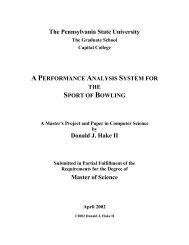k-Nearest Neighbor Classification on Spatial Data Streams Using P ...
k-Nearest Neighbor Classification on Spatial Data Streams Using P ...
k-Nearest Neighbor Classification on Spatial Data Streams Using P ...
You also want an ePaper? Increase the reach of your titles
YUMPU automatically turns print PDFs into web optimized ePapers that Google loves.
Input: P i,j for all i and j, basic P-trees and<br />
v i for all i, band values of target pixel<br />
Output: Pnn, closed-KNN P-tree<br />
// n - # of bands, m- #of bits in each band<br />
FOR i = 1 TO n-1 DO<br />
Pr i P i (v i )<br />
Pnn Pr 1<br />
FOR i = 2 TO n-1 DO<br />
Pnn Pnn & Pr i //initial neighborhood<br />
d 1 // distance for the first expansi<strong>on</strong><br />
WHILE RootCount(Pnn) < k DO<br />
FOR i = 1 to n-1 DO // expansi<strong>on</strong><br />
Pr i Pr i | P i (v i -d) | P i (v i +d)<br />
Pnn Pr 1 // ‘|’ - OR operator<br />
FOR i = 2 TO n-1 DO<br />
Pnn Pnn AND Pr i<br />
d d + 1<br />
Input: P i,j for all j, basic P-trees of all<br />
the bits of band i and the value v i for<br />
band i.<br />
Output: P i (v i ), the value p-tree for the<br />
value v i<br />
// m is the number of bits in each band<br />
// b i , j is the j th bit of value v i<br />
FOR j = 1 TO m DO<br />
IF b i,j = 1 Pt ij P i,j<br />
ELSE Pt i,j P′ i,j<br />
P i (v) Pt i,1<br />
FOR j = 2 TO m DO<br />
P i (v) P i (v) & Pt i,j<br />
Fig. 5(a). Algorithm to find closed-KNN set<br />
based <strong>on</strong> Max metric (Perfect Centering).<br />
5(b). Algorithm to compute value P-trees<br />
3.3 Finding the plurality class am<strong>on</strong>g the nearest neighbors<br />
For the classificati<strong>on</strong> purpose, we d<strong>on</strong>’t need to c<strong>on</strong>sider all bits in the class band.<br />
If the class band is 8 bits l<strong>on</strong>g, there are 256 possible classes. Instead, we partiti<strong>on</strong> the<br />
class band values into fewer, say 8, groups by truncating the 5 least significant bits.<br />
The 8 classes are 0, 1, 2, …, 7. <strong>Using</strong> the leftmost 3 bits we c<strong>on</strong>struct the value P-trees<br />
P n (0), P n (1), …, P n (7). The P-tree Pnn & P n (i) represents the pixels having a class<br />
value i and are in the closed-KNN set, Pnn. An i which yields the maximum root<br />
count of Pnn & P n (i) is the plurality class; that is<br />
predicted class = arg max{ RootCount( Pnn & P () i )}.<br />
i<br />
n<br />
4. Performance Analysis<br />
We performed experiments <strong>on</strong> two sets of Arial photographs of the Best Management<br />
Plot (BMP) of Oakes Irrigati<strong>on</strong> Test Area (OITA) near Oaks, North Dakota, United<br />
States. The latitude and l<strong>on</strong>gitude are 45°49’15”N and 97°42’18”W respectively. The<br />
two images “29NW083097.tiff” and “29NW082598.tiff” have been taken in 1997 and<br />
1998 respectively. Each image c<strong>on</strong>tains 3 bands, red, green and blue reflectance<br />
values. Three other separate files c<strong>on</strong>tain synchr<strong>on</strong>ized soil moisture, nitrate and yield<br />
values. Soil moisture and nitrate are measured using shallow and deep well<br />
lysimeters. Yield values were collected by using a GPS yield m<strong>on</strong>itor <strong>on</strong> the<br />
harvesting equipments. The datasets are available at http://datasurg.ndsu.edu/.
















